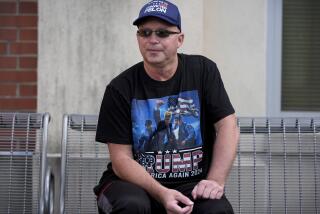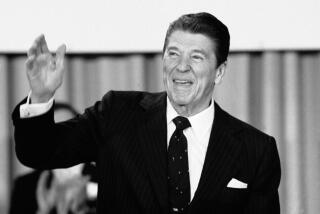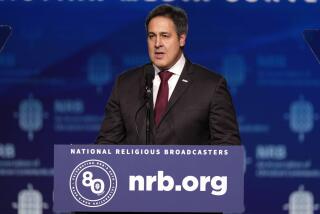Gingrich’s Plan for Power 10 Years in the Making
WASHINGTON — They said it couldn’t be done anymore: In the era of video politics and the decline of political parties, no one would ever again be able to rule Congress with the efficiency and iron control of the old bosses like Lyndon B. Johnson and Sam Rayburn.
But Newt Gingrich, the incoming Speaker of the House, may be rewriting the rules of modern politicking. He has followed an extraordinary 10-year plan to personally recruit, train and help finance the election of an army of new Republicans remarkably loyal to him and his agenda.
In the last four years alone, about half of the Republicans newly elected to the House were recruits of Gingrich’s so-called farm team. And nationwide, this network of Republican candidates running for all sorts of political offices has numbered 18,200.
The total number of Gingrich Republicans nationwide is impossible to measure. But some in Washington now consider his main recruiting arm, a GOP political action committee called GOPAC, to be more important than the Republican National Committee.
The “Newtonians,” as they call themselves--more suspicious Republicans call them “Newtoids”--are the product of a network of groups and ideas dubbed “Newt World” by its initiates, tirelessly tended by Gingrich and a cadre of Republican strategists who see themselves at the vanguard of a revolution of cultural conservatism and economic change.
Among other strategies, they have used political action committees in a unique way: not to dole out campaign funds to whatever Republicans happened to file for office but to recruit and train candidates who are enthusiastic about Gingrich’s populist Republican vision.
Headquarters supplied detailed manuals on campaigning to each candidate and conducted special conferences on campaign tactics around the country.
Each month, a package of video or audiotapes arrived with campaign do’s and don’ts or messages to refine the vision. Word lists coached them on how to “talk like Newt,” according to one document. And every Thursday, Gingrich himself was available for a personal briefing in scheduled telephone calls.
Today, many of these Republicans are not at all bashful about their bond to Gingrich or their plans to follow him. “I love Newt,” said one. “He is why I went to kindergarten and why I was a geek in college and graduate school. I can’t imagine a Republican world without him.”
“In effect, he has become a national ward boss,” said Steve Jost, a Democratic political consultant who managed two unsuccessful Georgia congressional campaigns to unseat Gingrich.
It remains to be seen how the team holds together once the centrifuge of a congressional session begins. Half a century ago, President Franklin D. Roosevelt also led a dedicated army of disciples in Congress, only to see many go their own way when times got tough.
But the Gingrich-led Republican team has already demonstrated that it is much more than a traditional political bloc. It has the seen-it-all political Establishment back on its heels, wondering what to expect next from the remarkable chemistry, cohesion and agenda the team has produced.
“Republicans had this Stockholm Syndrome,” said Lisa Nelson, executive director of GOPAC. “They identified with their captors (the Democrats). What Newt effectively said is: ‘Yes we can be the majority--and here is how.’ ”
Much of this began in the early 1980s, when Gingrich, then a young backbencher in the House, began to seek out other conservatives who wanted to remake the Republican Party. Even then, Gingrich had a long-term strategy.
Vin Weber, a now-retired Minnesota congressman, recalls the day that Gingrich, whom he knew only casually, approached him on the House floor:
“Have you thought about what you’re doing for the next 10 years?” Gingrich asked him.
They formed a cadre, Gingrich, Weber and Pennsylvania Rep. Robert S. Walker, bound by a vision that took Ronald Reagan’s philosophy of lower taxes and deregulation and blended it with a notion of the 21st Century, heavily influenced by the pop futurist writings of Alvin Toffler and John Naisbitt.
“It involved the whole idea that there is a macro-political and macroeconomic revolution taking place, with the ebbing of the industrial economy in favor of some new-wave economy. . . . Sitting and talking about revolution. There was a lot of that,” Walker said.
According to the concept, this technological and economic revolution would weaken elite structures, make the economy more international and make politics more grass-roots. But the people’s chances of capitalizing on the revolution were being undercut by Democratic social programs that made people dependent and eroded their values and sense of responsibility. To be the party of the future, Republicans needed to bind themselves to the idea of sweeping change.
By 1983, they started meeting at least once a week in Gingrich’s office to coordinate their actions on the House floor and muse over long-term strategy.
They quickly focused on the power of C-SPAN, the cable TV channel launched in 1979 that televised the actions of Congress, as a kind of political “Field of Dreams.” They decided to take two little-known parts of the congressional rules--”special orders” and “one minutes,” during which members of Congress may talk about anything they choose--and use them to espouse their vision. It didn’t matter that they were speaking to an absolutely empty chamber of Congress. With cable TV systems proliferating, they could potentially reach millions of voters.
They once spent an entire night talking about school prayer.
But the C-SPAN appearances did not spontaneously move the nation. They needed to do more. “We needed to create a farm team” of new Republican candidates, Walker recalls.
In 1986, after a false start with a group called the Conservative Opportunity Society, Gingrich became chairman of GOPAC, a political action committee founded seven years earlier by Republican Gov. Pierre S. (Pete) Du Pont IV of Delaware.
Traditionally, politicians had tried to use PACs to build political loyalty by raising money and then distributing it to other candidates who had a chance of winning.
Du Pont had the idea that GOPAC should actually recruit political hopefuls with like ideas and then mold them into candidates. Gingrich built on that, enlisting a businessman in one place, a school board member in another, a party volunteer in another. Many were political neophytes ready to be shaped.
As Gingrich campaigned by car around Michigan with another aggressive young Republican, now the state’s governor, John Engler, the two hit on the idea that candidates had a lot of time on their hands as they drove around their districts. If Gingrich could record tapes that detailed their revolutionary vision, give advice on how to run campaigns and frame issues, there might be a demand.
Before long, GOPAC was producing tapes every month. Gingrich aide Tony Blankley says GOPAC has sent out more than 70,000 tapes a year for several years, many of which feature Gingrich interviewing people who have run successful campaigns, nuts-and-bolts information and big-picture speeches by conservative leaders such as Gingrich or former British Prime Minister Margaret Thatcher.
Gingrich also began raising money around the country from conservative business leaders--in some cases hundreds of thousands of dollars from one person--with the special pitch that they were part of a movement to create a Republican House majority.
Gradually, headway was made. By the late 1980s, GOPAC was seeding legislatures and state parties with Gingrich’s farm team.
The summer of 1989 saw a turning point. For 18 days, Gingrich retreated to a remote mountain camp--without electricity or running water--called North Pole Basin near Crested Butte, Colo. Aides and GOPAC contributors came in small groups for three days at a time to plan.
A new tactical agenda was created, including a plan to make the House bank scandal a major issue to hurt Democrats, a commitment to come up with plans to help the inner city in an effort to attract more moderates and a decision to endorse term limits as a way to appeal to angry voters.
Gingrich and his team also decided that they were ready to take GOPAC to the next level--to train people to run for Congress.
The most famous GOPAC document is a memo by Gingrich called “Language, a Key Mechanism of Control,” in which the then-House minority whip gave candidates a glossary of words, tested in focus groups, to sprinkle in their rhetoric and literature. For example, it advised characterizing Democrats with such words as “decay, sick, pathetic, stagnation, corrupt, waste, traitors.”
Describe Republicans, in contrast, with “optimistic positive governing words,” like “share, change, truth, moral, courage, family, peace, duty.”
But GOPAC offered candidates much more. Gingrich also effectively gave his initiates what political consultants normally charge thousands of dollars a month to provide--detailed guidance on how to organize an office and where to look for contributions.
At the center of this was a little-known political adviser named Joe Gaylord, who helped save Gingrich’s career during two breathtakingly close reelection campaigns and who was once his chief of staff.
Gaylord wrote the manuals and designed the candidate classes. His approach, often less bureaucratic than the traditional Republican style, proved a winner: rely on volunteers, not paid professionals; keep repeating your message, and batter away relentlessly on “wedge” issues that tend to divide voters.
“Frankly, some Republican candidates make the mistake of worrying too much about what friends and neighbors and the so-called country club set might think if they ‘go negative’ and get aggressive,” he warned.
GOPAC literature also teaches how to sound compassionate while being tough: Don’t talk about supporting the death penalty, be “the defender of elderly people beaten up for their Social Security checks.”
Invoke “shield” issues, themes that protect Republicans from being characterized by Democrats as heartless. Move in on “turf” issues, such as advocating positions on the environment or education, that are traditionally Democratic. “You drive Democrats nuts,” Gingrich said in one GOPAC videotape.
And don’t shy away from the news media. Even though most reporters are liberal, one manual says, “as a matter of practical politics, the bias among reporters that is more important is their bias for news,” especially conflict and contrast.
In the 1994 election season, GOPAC held 37 courses around the country to drill candidates, GOPAC Executive Director Nelson said.
In addition to the classes, manuals and tapes, GOPAC arranged 30- to 45-minute conference calls with consultants four nights a week. And then there was the Thursday “Newt call.”
With each election, the farm team racked up more winners. By 1992, 21 of the 47 Republicans elected to the House were GOPAC recruits, and nationwide the group had 8,600 candidates running for office, GOPAC documents show.
By 1994, the farm team was even larger, 9,600 candidates, an overall mailing list of nearly 20,000 and 33 new members of the House.
Trolling for converts, Gingrich also reached out to raise money for non-farm team Republicans--137 congressional candidates--and he strong-armed other Republicans to do the same, making it clear that good committee assignments and leadership positions would depend on how hard they worked.
“Newt World” was now far-flung, from GOPAC to the National Republican Congressional Campaign Committee; the Friends of Newt Gingrich campaign committee; a weekly TV show on the conservative cable TV network, National Empowerment Television, and a think tank called the Progress and Freedom Foundation.
Its messages were coordinated with talk-show hosts such as Rush Limbaugh and with Christian Coalition groups.
“This was an army built on ideas,” Blankley said.
The Gingrich package is spreading beyond candidates directly to the public. Beginning in 1993, Gingrich began teaching a college course called “Renewing American Civilization.” Exactly how it was organized and financed is part of a House Ethics Committee investigation, but the concept is all part of the long-term strategy.
“The goal of this project is simple,” Jeffrey A. Eisenach, director of the Progress and Freedom Foundation, wrote in a fund-raising letter. “To train, by April, 1996, 200,000-plus citizens into a model for replacing the welfare state and reforming our government.”
Overall, about a quarter of House Republicans are farm team graduates, and more than half of the 231 House Republicans have listened to GOPAC tapes.
Among those who have not, virtually all acknowledge that it was Gingrich and his operation that led their party to a House majority--which most of them thought was impossible.
When the congressional session opens Jan. 4, Gingrich and his allies will begin methodically introducing in the House their “contract with America”--the 10 initial agenda items of their revolution.
There is strong opposition to some provisions, including among Senate Republicans. All of it, obviously, will not become law.
But no longer is anyone discounting the phenomenon that brought it forth and what this entity, if it remains intact, might be capable of doing.
‘Contract With America’
* The text of the Republican “contract with America” is available on the TimesLink on-line service. Also available are profiles of incoming House Speaker Newt Gingrich (R-Ga.) and other GOP leaders. Sign on and click “Special Reports” in the Nation & World section.
Details on Times electronic services, A10
More to Read
Get the L.A. Times Politics newsletter
Deeply reported insights into legislation, politics and policy from Sacramento, Washington and beyond. In your inbox three times per week.
You may occasionally receive promotional content from the Los Angeles Times.










